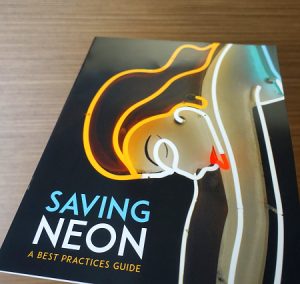CSA’s Dinner with Randall Ann Homan of Neon Speaks
Neon Speaks
The husband-and-wife duo that is Al Barna and Randall Ann Homan share deep roots in the San Francisco Bay Area arts and culture world, as well as a red-hot love for neon.
So much of the latter could be implied in the 2015 “San Francisco Neon: Survivors and Lost Icons,” the couple’s first published book spanning over four decades’ worth of images of vintage sign works, whether still glowing today or purely preserved in picture form.
Professional artists, photographers and graphic designers, Barna’s and Homan’s involvement with documenting and understanding these unique San Franciscan landmarks have developed into a greater effort in recent years.
In 2018, they published “Saving Neon: A Best Practice Guide” – a one-of-its-kind, 40-page answer on how to preserve neon signs. CSA member company Arrow Sign Company is listed as one part of the multi-member review team.
And, now headed into its fourth annual presentation, Barna and Homan have also spearheaded the multi-day Neon Speaks Festival in San Francisco.
Last year’s lineup included talks by former CSA speaker, Heather David, founder of The San Jose Signs Project and author of “Motel California,” and Tracey Sprague, the Collections Manager at the Neon Museum in Las Vegas who spoke on sign designer Betty Willis and her iconic design of the ‘Welcome to Fabulous Las Vegas’ sign.
Homan was invited to speak at the CSA dinner on Thursday, October 10, in Dublin, Calif., where she presented a spectacular collection of images and video capturing the essence of San Francisco’s vintage neon signs and how this often-nostalgic sign form has forged a distinctive presence even in today’s 13th most populous city in the nation.
The presentation included case studies of vintage sign preservation projects such as Timothy Pflueger’s Castro Theatre sign, a landmark brought back to life for the 2008 Hollywood biopic on San Francisco politician Harvey Milk, and other rare historical signs and stories.
The evening with Homan included a special question-and-answer session with the two-time neon book author and a book signing of her works.
In “Saving Neon: A Best Practices Guide,” fellow neon historians Dydia Delyser (a past CSA speaker) and Paul Greenstein write, “A neon sign retains the highest community and historical values when kept in its original location. Signs in the landscape reveal a geographical uniqueness and specificity; they help shape the very identities of their communities, something they can only achieve outdoors, in place.”
What neon signs found today in your local community resonate with these thoughts?
Barbara has been Communications Director for San Pedro Electric Sign Company since 1989. SPESCO is a full service custom sign manufacturer. She received her BA in Journalism, Public Relations from California State University-Long Beach, graduating in 2011. Barbara is currently 1st Vice President of the California Sign Association.






